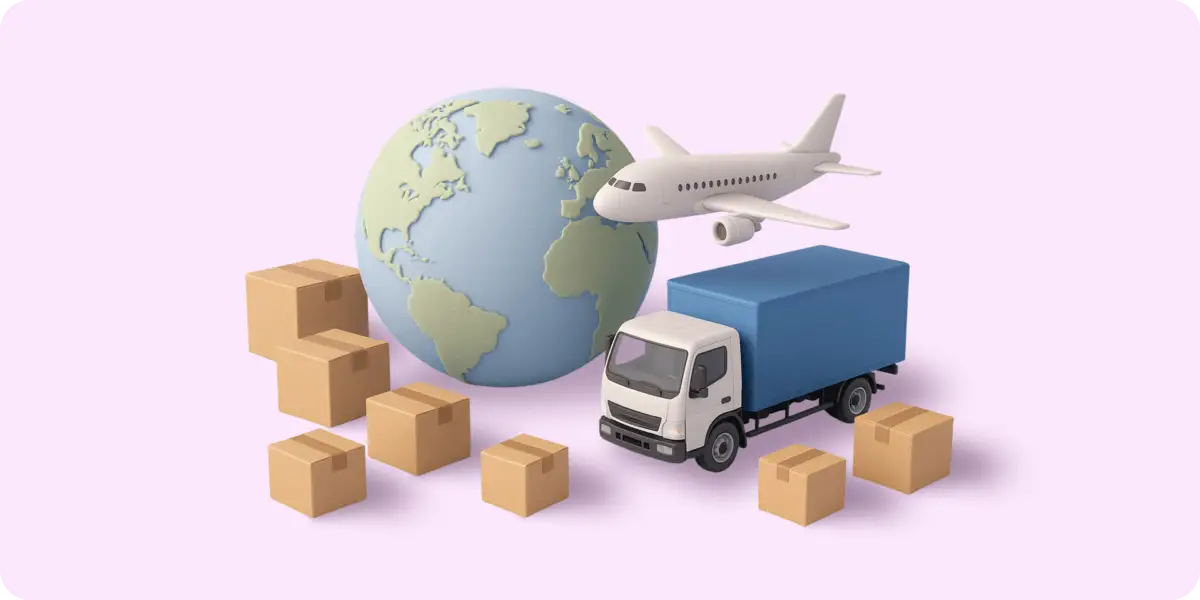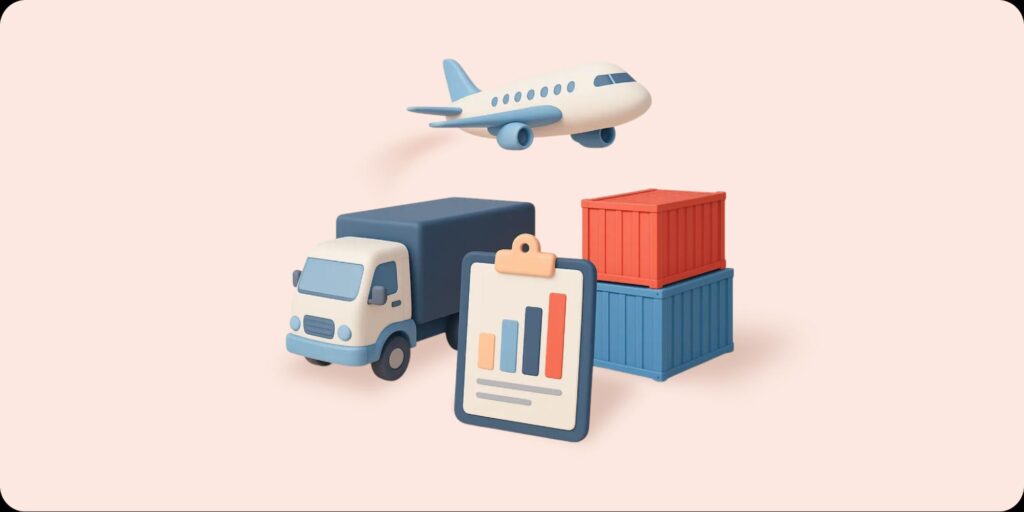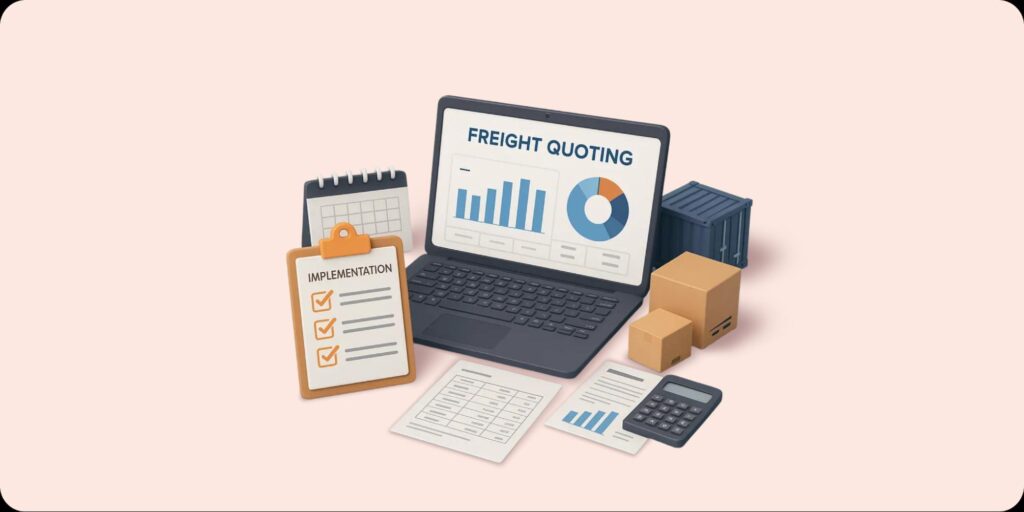Key Takeaways
- Freight forwarders manage multimodal shipping, customs, documentation, and carrier selection, delivering end-to-end logistics solutions that streamline complex global transport.
- Their consolidation strategies, real-time tracking, and compliance expertise help shippers cut costs, avoid delays, and simplify international trade.
- Choosing the right forwarder requires evaluating tech compatibility, global reach, pricing transparency, and regulatory knowledge, not just rates.
- Key risks include hidden costs, reliance on third-party networks, and increased damage potential due to multiple handoffs.
- Wisor reduces quote turnaround by 85% with AI-driven routing, automated compliance, real-time tracking, and carrier rate benchmarking, all in one platform.
What is Freight Forwarding?
Freight forwarders play a vital role in the logistics industry. The International Federation of Freight Forwarders Associations (FIATA) represents over 40,000 forwarding and logistics firms across approximately 150 countries. Forwarders facilitate transport by truck, rail, ocean, and air, with many offering multimodal solutions.
Acting as intermediaries between shippers and carriers, freight forwarders ensure timely and accurate delivery. While they are especially valuable in international shipping, many also manage domestic transport.
Unlike freight brokers, freight forwarders use their deep carrier networks and expertise in routing, documentation, and international regulations, making them invaluable, especially to shippers handling cross-border logistics.
How Freight Forwarders Operate
Freight forwarders serve as full-service intermediaries, managing everything from documentation and customs to cargo handling and carrier selection, unlike brokers who focus solely on carrier relationships.
Planning Routes and Securing Carriers
Freight forwarders maintain extensive networks of carriers, 3PLs, and warehouses. When cargo needs to be shipped, forwarders assess its size, origin, and destination to determine the optimal route and transportation partners. Established relationships with carriers allow forwarders to secure faster transport and negotiate better rates.
Coordinating Multimodal Shipping (Air, Sea, Road)
Forwarders often coordinate multimodal transport, for example, shipping by sea and arranging drayage by truck at ports. Some specialize in one mode, such as ocean cargo, while still coordinating related legs like trucking. Multimodal forwarders offer door-to-door service, managing a shipment from loading and port handling to rail transport and final delivery. They often collaborate with 3PLs to provide value-added services such as labeling, packaging, and handling.
Managing Shipment Consolidation
For partial shipments, consolidation significantly reduces per-unit cost. Freight forwarders use real-time tracking and carrier TMS integration to identify consolidation opportunities, maximizing load efficiency and lowering costs.
Handling Customs Documentation and Compliance
Handling customs, Incoterms, and regional documentation requirements is complex. Forwarders bring the expertise to ensure correct and timely compliance across different regions and transport providers.
Tracking Shipments in Real Time
Most offer real-time tracking across multiple modes, enabling visibility into shipment status and potential disruptions. Forwarders use this data to proactively respond to issues and maintain delivery timelines.
Good to Remember
Many forwarders default to carrier liability limits, which are often insufficient. Always verify cargo insurance values exceed replacement costs.
5 Stages in Freight Forwarding
Freight firms offer diverse services, and shippers should align these offerings with their specific logistics needs.
- Export Pickup and Haulage: The forwarder arranges transport from the origin warehouse to the port, coordinating with carriers to meet shipping schedules.
- Origin Handling & Export Customs: Forwarders manage all documentation for export clearance, including bills of lading, and may process export duties, billing them to the shipper or consignee.
- Freight Consolidation & In-Transit Monitoring: When applicable, forwarders consolidate shipments into shared containers and continuously monitor the cargo, including environmental conditions for sensitive items.
- Import Customs Clearance: At the destination port, the forwarder handles customs documentation and clearance, often processing duties or taxes and invoicing the appropriate party.
- Final Delivery: Forwarders arrange the final transport leg – from the arrival port or terminal to the final warehouse or delivery point.
Types of Freight Forwarding
Freight forwarding often involves intermodal and international services. Some forwarders specialize in a single mode, requiring multiple providers for complex routes.
- Air Freight: Shipments travel by plane, with drayage services handling transport to and from airports.
- Ocean Freight: Shipments travel by sea, often transitioning to road or rail for final delivery.
- Road Freight: Goods are transported by truck, either as the final delivery leg or the entire journey for regional shipments.
- Rail Freight: Cargo moves by train, typically used between ports and inland warehouses.
- Multimodal and Intermodal Solutions: Shipments transition between two or more modes, such as sea, rail, and road, for seamless door-to-door transport.
Pros & Cons of Freight Forwarding
A freight forwarding company streamlines cargo movement between carriers, across transport modes, and over international borders. However, like any logistics solution, it comes with both benefits and drawbacks.
| Pros of Freight Forwarding | Cons of Freight Forwarding | |
| Costs | Freight forwarders leverage advanced freight rate management tools, long-term carrier relationships, and volume-based bargaining power to negotiate significantly lower transport rates. They also consolidate smaller shipments to maximize container or truck capacity, reducing per-unit shipping costs. | While cost savings can be substantial, freight forwarder fees, covering coordination, documentation, and value-added services can be high, especially for smaller shipments or specialized cargo. |
| Compliance | Forwarders manage end-to-end regulatory compliance and documentation, including customs clearance, Incoterms, permits, and trade regulations, minimizing delays and costly errors. | Outsourcing complex compliance processes can become expensive, particularly when dealing with high-risk or multi-country shipments requiring specialized legal and regulatory oversight. |
| Network | Freight forwarders provide instant access to vast carrier and 3PL networks, enabling faster and more flexible transport solutions to almost any global destination. | Reliance on the forwarder’s network means shippers do not build their own long-term carrier relationships, limiting direct control over pricing and service. |
| Risk | Many forwarders offer optional cargo insurance and liability coverage, ensuring goods remain protected as they change carriers and transit modes. | Each additional third party in the chain increases the potential for loss, misrouting, or damage, especially if the forwarder does not include insurance or if coverage is insufficient for the shipment’s value. |
Pros
- Cost Reduction via Negotiated Rates: By consolidating cargo volumes across multiple clients and negotiating long-term contracts, freight forwarders secure more favorable rates than individual shippers typically could. They also leverage technology for real-time mode and route optimization, helping avoid costly delays from port congestion, route changes, or weather disruptions.
- Simplified International Compliance: Navigating complex customs regulations, trade documentation, and country-specific requirements is part of a forwarder’s daily operations. Their expertise ensures paperwork is accurate, complete, and submitted on time, reducing clearance delays and penalties.
- Global Network Access: Freight forwarders maintain relationships with carriers across air, sea, road, and rail, enabling seamless global logistics solutions. This network allows for faster bookings, priority scheduling, and more flexible routing options.
- Enhanced Shipment Visibility: Most forwarders provide clients with real-time tracking dashboards and status alerts, giving full transparency into shipment location, estimated arrival times, and potential delays.
Cons
- Reliance on Third Parties: While beneficial for reach, depending entirely on a forwarder’s network means the shipper lacks direct influence over carrier selection, performance standards, or future pricing negotiations.
- Risk of Delays and Hidden Costs: Without a clear and itemized quote, unexpected charges such as detention, demurrage, or congestion fees can quickly inflate costs. Delays in one leg of the journey can also cascade through multimodal routes.
- Potential for Damage or Loss: Transferring cargo between multiple carriers increases handling risks. Without sufficient insurance coverage or favorable Incoterms, the shipper may bear financial responsibility for losses.
Expert Tip: Treat Your Forwarder Like a Strategic Vendor, Not Just a Service Provider
- Enforce Tech Integration at Onboarding: Ensure the forwarder connects via EDI or API into your TMS or ERP from day one. This enables synchronized updates, instant rate pulls, and eliminates quote-related delays. Require this in RFQs.
- Pre-define Escalation Paths Across Modalities: Create SOPs that list specific forwarder contacts for each leg (dray, ocean, air, last mile). Especially critical for multimodal routes where disruptions in one leg ripple across others.
- Mandate Insurance Above Liability Limits: Many forwarders default to carrier liability rules (like $500 per container under Hague-Visby). Ensure insurance terms reflect true cargo value and align with Incoterms in use.
- Audit Rate Inputs Quarterly: Use internal rate audit tools or integrations like Wisor to compare contracted vs spot vs invoiced rates quarterly. Flag inconsistencies and recover overcharges before they impact margin.

Insight by
Nadav Shitrit
VP of AI, Wisor
Key Challenges and Best Practices in Freight Forwarding
Freight forwarding is a coordination sport: aligning carriers, shippers, schedules, and systems. With tens of thousands of carriers and even more shippers, each running different TMS, EDI, and messaging tools, keeping everything in sync is hard. The points below highlight the biggest friction areas and the practices that consistently reduce risk and delay.
Fragmented Carrier Communication
- Challenge: Disconnected systems and touchpoints lead to missed updates and coordination failures. Carriers often use different TMS platforms or rely on manual communications such as phone calls and emails, which can be slow and prone to errors.
- Best Practice: Choose a forwarder that uses integrated communication platforms capable of syncing directly with carrier systems. Maintaining close working relationships with carrier contacts also helps ensure critical updates are received and acted on quickly.
Manual Documentation and Compliance Burdens
- Challenge: Reliance on manual paperwork slows operations, increases error rates, and can cause customs clearance delays.
- Best Practice: Work with a forwarder that automates document generation and submission while still including human review to ensure accuracy and compliance with varying regulations.
Lack of Real-Time Shipment Visibility
- Challenge: Shipments often pass through multiple carriers and modes, making visibility a challenge. Without real-time updates, forwarders can’t anticipate or prevent delays.
- Best Practice: Select a forwarder that offers live tracking dashboards, IoT-enabled monitoring devices, and predictive analytics for proactive problem resolution.
Pricing Inefficiencies and Rate Inconsistencies
- Challenge: Freight costs can fluctuate due to spot rates, surcharges, and accessorial fees, making budgeting difficult.
- Best Practice: Use forwarders that employ freight rate intelligence tools to monitor market trends and provide transparent rate comparisons across carriers and modes.
Cargo Damage, Loss, or Delays
- Challenge: Multiple handoffs increase the risk of damage, misrouting, or loss.
- Best Practice: Ensure the forwarder offers robust cargo insurance options and clearly defined Incoterms to protect financial interests throughout the journey.
Tools & Technologies for Freight Forwarding
Modern forwarders run on software. To orchestrate carriers, customs authorities, and customers at scale, teams lean on an integrated stack for planning, execution, and visibility. While toolsets vary (and some platforms bundle multiple modules), most freight forwarder technology includes the capabilities outlined below.
Freight Management Platforms
Comprehensive solutions that centralize carrier integration, rate comparisons, shipment booking, resource allocation, document automation, and real-time tracking, reducing the need for multiple disconnected tools.
Tracking and Analytics Software
Enables forwarders to monitor shipment location, carrier performance, and delivery timelines in real time. Advanced platforms also provide analytics to identify recurring issues, optimize future routes, and benchmark carrier reliability.
Document & Customs Automation
Speeds up the preparation and submission of bills of lading, customs declarations, and regulatory documents. These tools reduce human error, accelerate customs clearance, and maintain compliance with country-specific regulations.
Rate Comparison Engines
Aggregate data from negotiated contracts, spot rates, and market indexes to recommend the most cost-efficient carrier and mode for each shipment. This allows forwarders to optimize cost without sacrificing delivery speed.
How to Choose the Right Freight Forwarder for Your Needs
Selecting a forwarder is less about price and more about fit. Evaluate how well they match your stack, lanes, compliance profile, and transparency expectations. Use the checklist below to assess technology compatibility, service depth, and total-cost clarity before you commit:
|
Consider |
Look For |
| Technology Match | A platform that integrates seamlessly with your systems, either directly or through API connectivity, to enable real-time data exchange. |
| Global Network | A carrier and partner network covering all regions where you need to ship. |
| Compliance Expertise | Proven ability to manage customs and regulatory requirements specific to your cargo type and destinations. |
| Pricing Model Transparency | Upfront, itemized quotes without excessive markups on surcharges. Forwarders who offer congestion-avoidance strategies add extra value. |
| Services Match | Support for the full scope of your needs, such as warehousing, drayage, multimodal transport, dangerous goods handling, and customs clearance. |
| Risk Management | Availability of cargo insurance and favorable Incoterms to protect your goods throughout the shipping process. |
How Wisor Speeds Up Quoting & Boosts Profit Margins for Freight Forwarders
Wisor streamlines operations end to end with a freight forwarding platform built for faster quoting, smarter routing, and tighter cost control. Here’s how Wisor automates the heavy lifting and surfaces profit-saving insights across your workflows
- AI-Powered Route Optimization and Insights: Wisor integrates with carrier TMS platforms and real-time logistics data sources to recommend optimal routes, avoiding congestion points and reducing delays. This results in improved delivery timelines and lower operational costs.
- Automated Compliance & Document Generation: The platform automatically prepares shipment-specific documentation, such as bills of lading and customs forms, based on cargo type and destination. These are routed according to predefined workflows, ensuring deadlines are met without manual bottlenecks.
- Live Shipment Visibility & Analytics: Wisor offers a centralized dashboard for real-time shipment tracking, predictive ETAs, and historical performance metrics. This helps logistics teams identify inefficiencies and improve future planning.
- Carrier/Rates Comparison Tools: By benchmarking carrier rate cards against live market indexes, Wisor automatically recommends the most cost-effective carrier and transport mode for each shipment lane, helping forwarders protect margins without compromising service quality.
Conclusion
Freight forwarding is a complex yet essential component of modern logistics. For smaller shippers, they unlock global expansion; for larger businesses, they deliver efficiency, compliance, and cost savings. The key is choosing a forwarder whose strengths align with your operational and technology needs.
Wisor brings together carrier data, documentation automation, analytics, and live tracking – all in one platform. Experience it in action!







